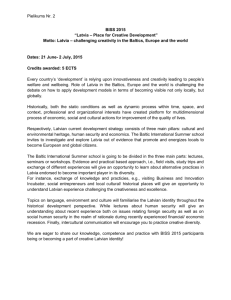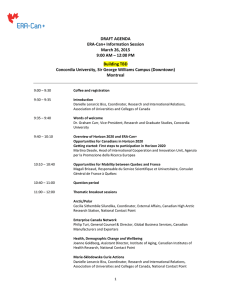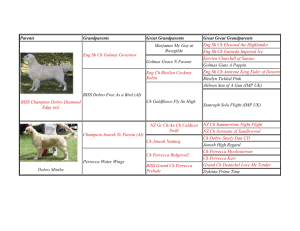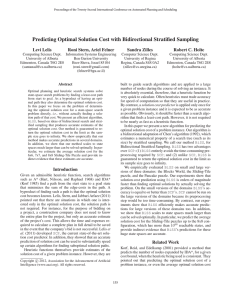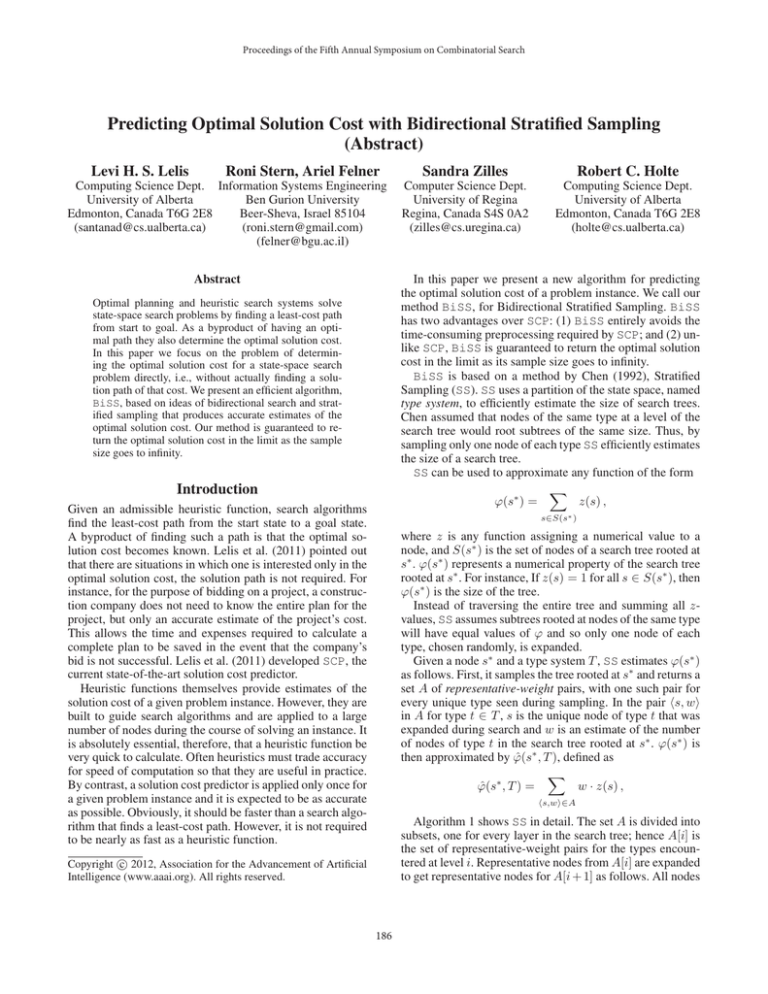
Proceedings of the Fifth Annual Symposium on Combinatorial Search
Predicting Optimal Solution Cost with Bidirectional Stratified Sampling
(Abstract)
Levi H. S. Lelis
Roni Stern, Ariel Felner
Computing Science Dept. Information Systems Engineering
University of Alberta
Ben Gurion University
Edmonton, Canada T6G 2E8
Beer-Sheva, Israel 85104
(santanad@cs.ualberta.ca)
(roni.stern@gmail.com)
(felner@bgu.ac.il)
Abstract
Sandra Zilles
Robert C. Holte
Computer Science Dept.
University of Regina
Regina, Canada S4S 0A2
(zilles@cs.uregina.ca)
Computing Science Dept.
University of Alberta
Edmonton, Canada T6G 2E8
(holte@cs.ualberta.ca)
In this paper we present a new algorithm for predicting
the optimal solution cost of a problem instance. We call our
method BiSS, for Bidirectional Stratified Sampling. BiSS
has two advantages over SCP: (1) BiSS entirely avoids the
time-consuming preprocessing required by SCP; and (2) unlike SCP, BiSS is guaranteed to return the optimal solution
cost in the limit as its sample size goes to infinity.
BiSS is based on a method by Chen (1992), Stratified
Sampling (SS). SS uses a partition of the state space, named
type system, to efficiently estimate the size of search trees.
Chen assumed that nodes of the same type at a level of the
search tree would root subtrees of the same size. Thus, by
sampling only one node of each type SS efficiently estimates
the size of a search tree.
SS can be used to approximate any function of the form
X
ϕ(s∗ ) =
z(s) ,
Optimal planning and heuristic search systems solve
state-space search problems by finding a least-cost path
from start to goal. As a byproduct of having an optimal path they also determine the optimal solution cost.
In this paper we focus on the problem of determining the optimal solution cost for a state-space search
problem directly, i.e., without actually finding a solution path of that cost. We present an efficient algorithm,
BiSS, based on ideas of bidirectional search and stratified sampling that produces accurate estimates of the
optimal solution cost. Our method is guaranteed to return the optimal solution cost in the limit as the sample
size goes to infinity.
Introduction
Given an admissible heuristic function, search algorithms
find the least-cost path from the start state to a goal state.
A byproduct of finding such a path is that the optimal solution cost becomes known. Lelis et al. (2011) pointed out
that there are situations in which one is interested only in the
optimal solution cost, the solution path is not required. For
instance, for the purpose of bidding on a project, a construction company does not need to know the entire plan for the
project, but only an accurate estimate of the project’s cost.
This allows the time and expenses required to calculate a
complete plan to be saved in the event that the company’s
bid is not successful. Lelis et al. (2011) developed SCP, the
current state-of-the-art solution cost predictor.
Heuristic functions themselves provide estimates of the
solution cost of a given problem instance. However, they are
built to guide search algorithms and are applied to a large
number of nodes during the course of solving an instance. It
is absolutely essential, therefore, that a heuristic function be
very quick to calculate. Often heuristics must trade accuracy
for speed of computation so that they are useful in practice.
By contrast, a solution cost predictor is applied only once for
a given problem instance and it is expected to be as accurate
as possible. Obviously, it should be faster than a search algorithm that finds a least-cost path. However, it is not required
to be nearly as fast as a heuristic function.
s∈S(s∗ )
where z is any function assigning a numerical value to a
node, and S(s∗ ) is the set of nodes of a search tree rooted at
s∗ . ϕ(s∗ ) represents a numerical property of the search tree
rooted at s∗ . For instance, If z(s) = 1 for all s ∈ S(s∗ ), then
ϕ(s∗ ) is the size of the tree.
Instead of traversing the entire tree and summing all zvalues, SS assumes subtrees rooted at nodes of the same type
will have equal values of ϕ and so only one node of each
type, chosen randomly, is expanded.
Given a node s∗ and a type system T , SS estimates ϕ(s∗ )
as follows. First, it samples the tree rooted at s∗ and returns a
set A of representative-weight pairs, with one such pair for
every unique type seen during sampling. In the pair hs, wi
in A for type t ∈ T , s is the unique node of type t that was
expanded during search and w is an estimate of the number
of nodes of type t in the search tree rooted at s∗ . ϕ(s∗ ) is
then approximated by ϕ̂(s∗ , T ), defined as
X
ϕ̂(s∗ , T ) =
w · z(s) ,
hs,wi∈A
Algorithm 1 shows SS in detail. The set A is divided into
subsets, one for every layer in the search tree; hence A[i] is
the set of representative-weight pairs for the types encountered at level i. Representative nodes from A[i] are expanded
to get representative nodes for A[i + 1] as follows. All nodes
c 2012, Association for the Advancement of Artificial
Copyright Intelligence (www.aaai.org). All rights reserved.
186
Experimental Results
Algorithm 1 Stratified Sampling
∗
1: input: root s of a tree and a type system T
2: output: an array of sets A, where A[i] is the set of pairs hs, wi at level i.
3: A[0] ← {hs∗ , 1i}; i ← 0
4: while stopping condition is false do
5:
for each element hs, wi in A[i] do
6:
for each child ŝ of s do
7:
if A[i + 1] contains an element hs0 , w0 i with T (s0 ) = T (ŝ) then
8:
w0 ← w0 + w
9:
with probability w/w0 , replace hs0 , w0 i in A[i + 1] by hŝ, w0 i
10:
else
11:
insert new element hŝ, wi in A[i + 1].
12:
end if
13:
end for
14:
end for
15:
i←i+1
16: end while
Our experiments are run in three domains: the Blocks World,
the Sliding-Tile puzzle, and the Pancake puzzle. However,
due to space constraints we show results only on the (5x5) 24
sliding-tile puzzle (24-puzzle). For more empirical results
see the extended version of this paper (Lelis et al. 2012).
Solution cost predictions are compared using relative absolute error (Lelis, Stern, and Jabbari Arfaee 2011) for a set
of optimal solution costs. For all start states with optimal solution cost X one computes the absolute difference of the
predicted solution cost and X, adds these up, divides by the
number of start states with optimal solution cost X and then
divides by X. A system that makes perfect predictions will
have a relative absolute error of 0.00.
Cost
96
98
100
102
104
in A[i] are expanded and the children of each node in A[i]
are considered for inclusion in A[i + 1]. If a child ŝ has a
type t that is already represented in A[i + 1] by another
node s0 , then a merge action on ŝ and s0 is performed. In
a merge action we increase the weight in the corresponding
representative-weight pair of type t by the weight w(s) of
ŝ’s parent s. ŝ will replace the s0 according to the probability shown in line 9.
BiSS is a bidirectional variant of SS for predicting optimal solution costs. It interleaves the execution of two copies
of SS, one proceeding forwards from the start state, the other
proceeding backwards from the goal state. BiSS switches
between the two searches when one iteration of the loop in
lines 4 to 15 of Algorithm 1 has finished. One “step” in a
particular direction thus corresponds to the expansion of all
the representative nodes at a given level. When referring to
the array A in the SS algorithm, we will use AF for the forward search and AB for the backward search.
BiSS’s stopping condition is based on the set of types
that have occurred at each level of the searches. We define τ F [n] = {T (s)|hs, wi ∈ AF [n]}, the set of types of
the nodes expanded at level n by the copy of the SS algorithm searching forward from the start state, and τ B [m] =
{T (s)|hs, wi ∈ AB [m]}. BiSS stops the bidirectional sampling with an estimate of the optimal solution cost when the
type sets at the frontiers of the two searches overlap for several consecutive levels. We called this stopping condition a
“match” between the two searches, defined as follows.
Definition 1. (match) – For any n and m we say that τ F [n]
and τ B [m] match if τ F [n + r]∩τ B [m − r] 6= ∅ for all r ∈
{0, 1, · · · , K} where K = max{bγ · mc, 1}. Here γ ∈ [0, 1]
is an input parameter.
After each step in each direction BiSS tests if the same
type occurs in both τ F [n] and τ B [m], where n and m are
the most recently generated levels in the respective search
directions. If this happens, BiSS extends the forward search
up to level n + K so that a match, as defined in Definition 1,
can be fully tested. If a match occurs at step n from the start
state and at step m from the goal state, then the searches
terminate and n+m is returned as an estimate of the optimal
solution cost.
Relative Absolute Error
BiSS
h
0.05
0.25
0.03
0.26
0.03
0.26
0.04
0.25
0.03
0.25
Table 1: 24-puzzle
Table 1 shows the relative absolute error of the predictions of BiSS and Manhattan Distance (the heuristic we use
to build BiSS’s type system) on the 24-puzzle for start states
with different solution costs. As can be observed, BiSS
makes very accurate predictions — the most inaccurate predictions shown in Table 1 are for start states with optimal
solution cost of 96, and even then BiSS makes predictions
that are only 5% longer (or shorter) than the optimal solution
cost on average. Equally accurate predictions were made in
the other two domains we tested.
Conclusion
We presented BiSS, an efficient algorithm that accurately
predicts the optimal solution cost without finding a least-cost
path from start to goal. BiSS does not require preprocessing
and is guaranteed to return the optimal solution cost in the
limit as the number of its probes goes to infinity.
Acknowledgements
This work was supported by the LCD at the University of
Regina, AITF, AICML, and NSERC.
References
Chen, P.-C. 1992. Heuristic sampling: A method for predicting the performance of tree searching programs. SIAM
Journal on Computing 21:295–315.
Lelis, L.; Stern, R.; Felner, A.; Zilles, S.; and Holte, R. C.
2012. Predicting optimal solution cost with bidirectional
stratified sampling. In ICAPS.
Lelis, L.; Stern, R.; and Jabbari Arfaee, S. 2011. Predicting optimal solution costs with conditional probabilities. In
SoCS, 100–107.
187



